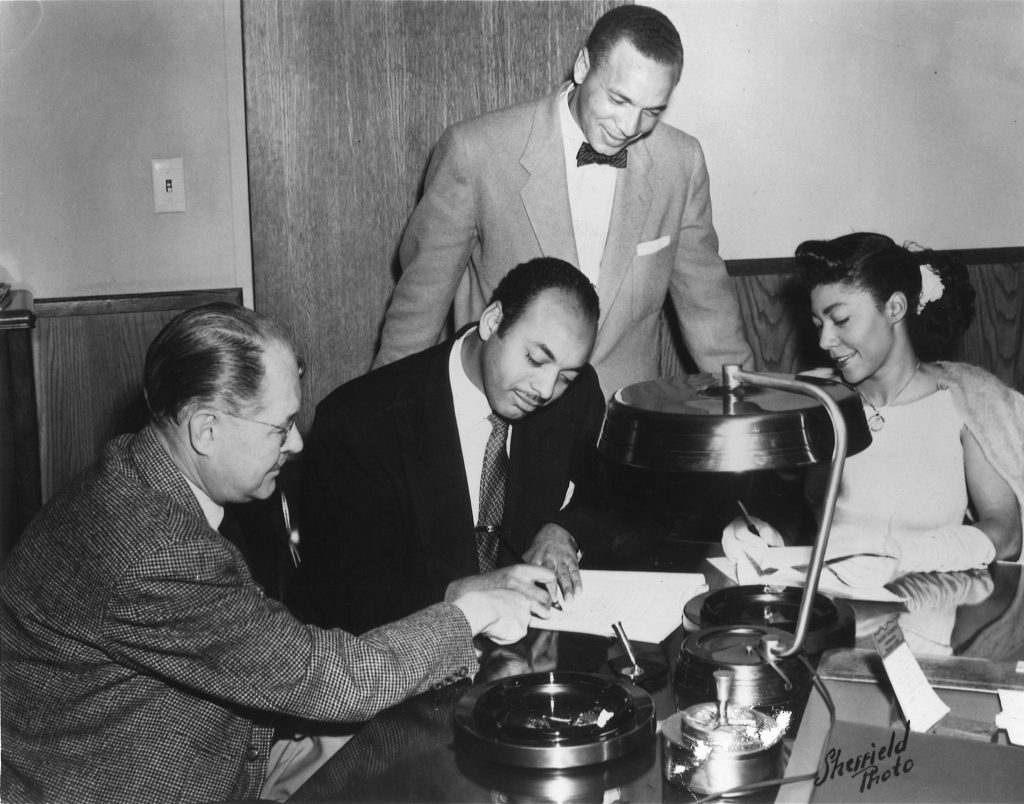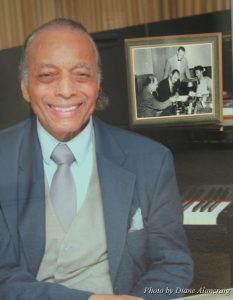
Rhythm Club President, Marl – pictured with Musicians’ Club Secretary Maury Paul (left), NAACP Secretary Lester Bailey (standing, center) and Rhythm Club Secretary Estelle Edson (right) – signs the final document transferring Local 767 Rhythm Club assets to the Local 47 Musicians’ Club of Los Angeles in March of 1953, marking the final step in the amalgamation of the two Locals. (Photo: AFM Local 47 Overture archives)
Throughout his esteemed career, Marl Young was known for breaking ground. A civil rights leader within the American Federation of Musicians, he was instrumental in the historic merger of the former all-black Local 767 and all-white Local 47 in the 1950s, which set the precedent for desegregation within the entire musicians union of the United States and Canada. In 1970 he became the first black music director of a major network television series, “Here’s Lucy.” Young served as a longtime director of the Los Angeles musicians union and remained an activist until his retirement in January 2009. He died on April 29, 2009, at age 92.
The following is excerpted from an article by Linda A. Rapka originally published in the February 2009 edition of Overture:
Born in Bluefield, Virginia in 1917, Marl’s family moved to Chicago in 1923. He began teaching himself to play the piano at the tender age of 6. His family quickly saw he had a natural talent and started Marl with piano lessons. He began playing professionally at 14, and by 16 was already a card-carrying union musician.
In 1941, Marl started rehearsing and writing music for night clubs and floor shows at the Rhumboogie Night Club in Chicago, where he wrote arrangements for Benny Carter. He decided to move to California in 1947. He set out in his beat-up Pontiac, looking forward to a new job with Louie Jordan, who promised to hire Marl as Bill Davis’ replacement. Arriving with all of $15 in his pocket, expecting to start working right away, Marl got to the studio only to learn that Louie, who was unsure when Marl would be arriving, had already hired somebody else.
As fate would have it, Martha Davis of the Martha Davis and Spouse act was there at the studio and offered Marl a job writing arrangements for her recording session. A month later he began working his first regular job at the Last Word on Central Avenue with a band playing for Jimmy Witherspoon.
At this time Marl joined the black musicians Local 767, located at 1710 Central Ave. He soon became deeply involved with the movement to unite 767 with the white Local 47. Sounding sharp and articulate as ever, Marl discussed his time working toward this amalgamation from his home by telephone.
“I came from a segregated Local in Chicago,” Marl said. “Segregation was a way of life. So I just went down to 39th and State Street, borrowed $50 from sister in law, and joined in 1933. Nobody thought too much of it at the time. It was just the way things were.”
This would soon change in the early 1950s, after Marl moved to Los Angeles.
“There was a group of us that got together and said we wanted to end segregation in Local 47. The purpose of each union, as stated in the Bylaws, was to unite all the professional musicians of the Los Angeles area. To unite the two organizations would be proper, because it would live up to that portion of the Bylaws. I got involved because of people like Bill Douglass, Buddy Collette and others who had already starting working on the amalgamation movement. One morning in 1951, a fellow named John Anderson came to my house and said he wanted me to come to a meeting. Buddy Collette was there, John Ewing was there, and others, and said to me, ‘We want you to get involved in amalgamation movement,’ and I got involved. There were problems that had to be solved and the amalgamation proposal that I wrote dealt with the problems that had to be solved before we could amalgamate.”
Marl spent many late nights doing strategic planning along with Benny Carter, Buddy Collette, Estelle Edson and many others. “Over a period of three years we worked hard enough that we got the vote that was needed,” he said. In 1952 he wrote the merger agreement that the two unions later voted upon. In January 1953, Local 767 voted in favor of the amalgamation by more than a two-thirds majority. The two Locals officially merged as one April 1, 1953, forever erasing racial segregation within the Los Angeles musicians union.
“When we achieved our amalgamation, then it became evident to the AFM that segregation was on the way out,” said Marl. “That’s when they started their civil rights movement.” Local 47 was the first to amalgamate within the AFM, setting the precedent for which every other segregated Local would follow.
In 1957, Marl became the first black member of the Local 47 Board of Directors, remaining in this position for four years.
During this time Marl got the biggest break of his career. In 1958 he received a call from singer Marilyn Lovel asking him to accompany her on an audition for the Lucille Ball-Desilu Workshop Theater. After performing her two numbers, she was asked to come back — as was Marl, which was highly unusual, as accompanists were not technically considered as In 1959 he began doing the basic arrangements for the workshop theater. Then in 1962, he was asked by Desi Arnaz to perform as pianist in the show’s warm-up band for the studio audience, and continued to work on the show for several years.
In 1970 Marl became the first black music director of a major network television show after the death of longtime “Lucy” music director Wilbur Hatch. In this new capacity, Marl decided to hire three black musicians for the show, telling executive producer, Lucy’s then-husband Gary Morton, “I would like the people to understand me when I work for them. I am going to integrate the recording orchestra.” He hired Jackie Kelso on sax, John (Streamline) Williams on trombone, and Melvin Moore on trumpet.
In 1972, Marl again ran for Local 47’s Board, and won. After “The Lucy Show” came to a halt in 1974, he decided to run for the full-time position of Local 47 Secretary and won by a landslide, serving for eight years — all the while serving on numerous arts, entertainment and advisory committees, including NAACP, Democratic Minority Conference and California Arts Council. Many of the Local 47 Bylaws in effect today were written while Marl was chair of the Local’s Legislative Committee.
Marl fulfilled his last term as Director of Local 47 in 2008 and offers these words of wisdom to those who will continue to serve the Local: “Don’t give up reaching for your goals, and always work within the Bylaws or guidelines that are in effect at the time. As long as you work within the proper channels, you can make change happen the right way.”

